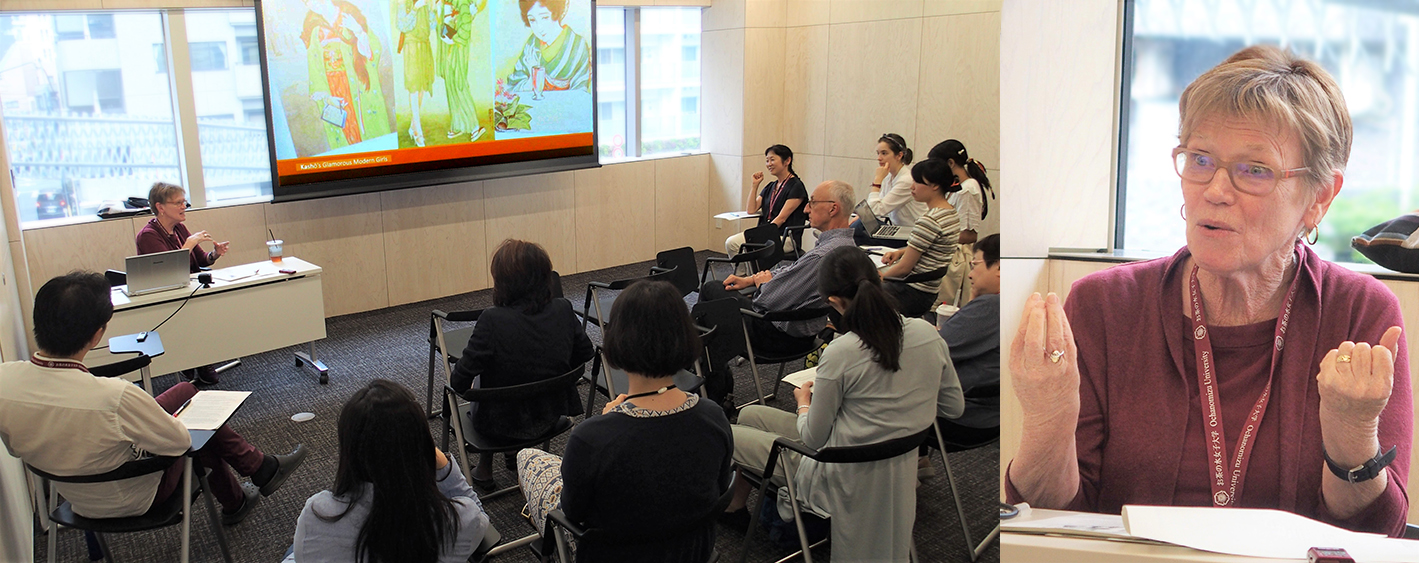IGS Seminar: Fashion Show Diplomacy in Early Cold War Japan: A Critical Feminist Perspective
On July 10, 2019, the Institute for Gender Studies (IGS) at Ochanomizu University hosted a seminar featuring a lecture by Dr. Jan Bardsley (Specially Appointed Professor at IGS/Professor at North Carolina University at Chapel Hill) entitled “Fashion Show Diplomacy in Early Cold War Japan: A Critical Feminist Perspective.” The lecture was based on Bardsley’s ongoing research project which examines the influence of Cold War politics on Japanese fashion culture in the 1950s, with a particular focus on methodology.

Bardsley is interested in how the concept of democracy was packaged and delivered to women in post-war Japan. Advice on how to become a democratic woman can be found in Japanese women’s magazines of that period, even in articles about etiquette and beauty. These magazines imply that voting alone was not sufficient for becoming a democratic woman. Women had to alter their bodies, make-up, and hairstyles in order to attain the appropriate appearance of a democratic woman. Such surprising cultural practices led Bardsley to become interested in the political aspects of beauty contests and fashion shows in the 1950s. In this seminar, it is revealed that the popularity of fashion shows in Japan in the 1950s was intimately connected to the existence of U.S. military forces during the occupation period and the early Cold War era.
The popularity of fashion shows among American women originated from the charitable and patriotic activities of the post-World War I period. Elite women’s clubs on the East Coast organized fashion shows to support soldiers wounded in the war. Fashion show culture gradually spread to other women’s groups, including those of African Americans and Asian Americans. After World War II, this culture was brought to Japan by American women, such as the wives of U.S. military men and female staff of Supreme Commander for the Allied Powers. American women from a variety of social backgrounds formed clubs in Japan. One thing they had in common was their love for fashion shows, and as a result, fashion shows became a kind of a space for equality. American women invited Japanese women to their fashion shows. The appearances and manners of American models participating in the events served not only as representations of beauty but also as models of democratic womanhood. Bardsley presented several insights which contribute to our critical understanding of these fashion shows from the perspective of gender.
Ann Sherif, the author of Japan’s Cold War, states that post-war Japan tends to be discussed in comparison with the pre-war situation, arguing that the early Cold War political structure must also be taken into account when analyzing post-war Japan. As mentioned above, such an approach is central to Bardsley’s discussion. In Cold War Orientalism, Christina Klein discusses the role of films and novels about Asia in promoting Cold War ideology in the U.S. These productions espoused that Americans must make friends all over the world. Moreover, it stressed that through a so-called “people to people” project, the U.S. could liberate people all over the world. What was emphasized here is that unlike European imperialism, the U.S. vowed it would respect different cultures and connect people through shared values. Mire Koikari, however, points out that the relationship between the U.S. and Japan resembles the relationship between empire and colony. In her book Pedagogy of Democracy, she describes this as “imperial feminism.” Koikari reveals that some American women who came to Japan had intended to liberate Japanese women by presenting themselves as role models. In fashion shows, American women functioned as models while Japanese women aspired to resemble them in appearance. Such a structure is comparable to an imperialistic power imbalance. The concept of “contact zones” as suggested by Mary Pratt describes the nature of fashion show spaces. Contact zones are places where different cultures meet, crash, and wrestle. Power imbalances are common in such spaces. The space of the fashion show in Japan was firstly a contact zone where American women from different social and cultural backgrounds met. Secondly, it served as a contact zone where American and Japanese women met. The power structure in such a contact zone was surely complex.
After presenting a historical background and introducing analytical concepts, Bardsley engaged the audience in a discussion. The presentation continued, detailing what activities were carried out in contact zones, such as the establishment of the Tina Leser Fashion Design Prize for Japanese designers, the carrying out of fashion shows celebrating the conclusion of the San Francisco Peace Treaty, and the training of Japanese women to become fashion models. The enthusiastic discussion continued, and comments from the audience brought up complementary topics, such as home sewing culture; standardization of body size and the development of mass production of clothes; the relationship between fast-fashion production and colonialism; and the role of fashion in communist countries. Bardsley plans to publish a book documenting the outcome of this research project, and we are very much looking forward to its publication.
Kumi Yoshihara (Project Research Fellow, IGS)
《Reference》
- Sherif, Ann (2009) Japan’s Cold War: Media, Literature, and the Law, New York: Columbia University Press.
- Klein,Christina (2003) Cold War Orientalism: Asia in the Middlebrow Imagination, 1945-1961, Berkeley: University of California Press.
- Koikari, Mire (2008) Pedagogy of Democracy: Feminism and the Cold War in the U.S. Occupation of Japan, Philadelphia, PA: Temple University Press.
- Koikari, Mire (2015) Cold War Encounters in US-Occupied Okinawa: Women, Militarized Domesticity and Transnationalism in East Asia, Cambridge University Press.
- Pratt, Mary Louise (1991) ‘Arts of the Contact Zone’, Profession, No.91 pp.33-40.
- Pratt, Mary Louise (1992) Imperial Eyes: Travel Writing and Transcription, New York: Routledge
【Event Information】 http://www2.igs.ocha.ac.jp/en/events/2019/07/0710/

